Modernization of the old-style telephone (telephone roulette).
The essence (goal?) Of the project
- At that time it was a project for regional competitions in radio electronics and radio design.
Next on the list:
- Choose an idea - upgrade phone.
- Create a device based on a PIC16 microcontroller.
- More ASM language learning as well as C.
- Create a usable device through which you can call.
- that still =)
More precisely, the essence of the modernization of the phone is the following - to bring the old phone with a drum dial in human form, replace the entire front panel. And stick a 4x4 keyboard and a 20x4 display onto it. Connect and assemble so it would work.
')
What do we need?
First you need to know what we can. from this and to proceed, at that time I owned the PIC12 / 16 controllers and chose PIC16F877A.
Programmer debugger ICD2 Bulgarian production ~ 2.5k rubles. Please note that it works in MPLAB native program for Windows as well as in Piklab on Linux via USB
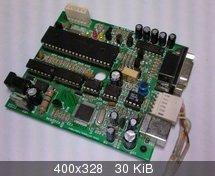
Datasheet on the controller that will be used in the device can be found here microchip
Ordinary plastic DIP40 case (sorry for money pottery)
Ask the question why DIP40?
- Firstly, we need to ensure the verification of the buttons, and we have a 4x4 keyboard - in our case, one port of the controller is already taken.
- Secondly, we need to connect the display 20x4 and there are 16 contacts for control.
- Thirdly, it will also be necessary to dial the number, coax, blink, system LEDs inside the case.
- Well, “The stock pocket does not pull.”
One could of course put the display and keyboard on one port, but at that time my project was “on fire”, so it was the perfect choice.
A little about the display, the display was used 4 lines of 20 characters each, you can see the datasheet on the display here 20x4 LCD
I will say that this is an easy-to-learn display. (Not so much as a pinnacle that I recently tinker with)
We will also need a little bit besides the display and the controller =) well, yes, some more brain and free time.
Go! (with)
As I have already said, the victim of my alteration was the old landline phone, I cannot show the photo in its original form for obvious reasons.
everything superfluous was removed from it, and it looked like this:

Then the circuit was developed and the board was made.
The board is made in a pencil type :) i. You go to the store, you buy a marker with a special varnish, and draw paths by hand, and then poison it as usual.
The turn of the board (i.e. the tracks) can also be observed
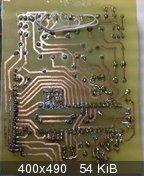
In general, after we all soldered, and prepared it should look that way or better :)
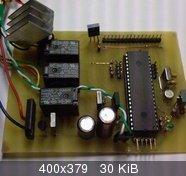
Next, we make the body, somehow we cut off the entire front panel from this brittle plastic, and we make our own - a new one. in it we make rectangular cuts for the keyboard and display. here of course it was possible for me to be careful but =) in general we put all this murkiness inside
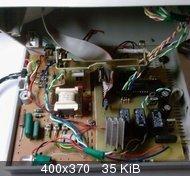
We check the assembly of our device, and close / turn on and see what we did, I have this
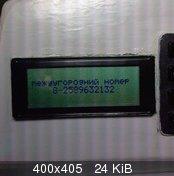
General view of the assembled device

Button Assignments
- 1, 2, 3, 4, 5, 6, 7, 8, 9, 0 - as usual
- * - this is the backlight
- the most right upper one is “mute”
Pinout for keyboard
The keyboard is standard, front view.
1................2................3................()
4................5................6................()
7................8................9................()
*................0................#................()
.........RC0..RC1..RC2..RC3..RC4..RC5..RC6..RC7.......And I was not too lazy to restore the circuit diagram of the board and firmware.
I made it as usable as possible, so I executed it in sPlan 6.0
- Download not installed splan
- Download the installed splan there I ruled some + scheme in the same splan
- Who already has this program can just download the scheme
- To whom laziness / no program can see the image of the scheme :)
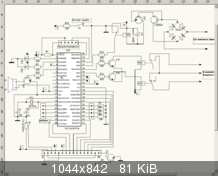
Now I will tell all sorts of things that he has
- The device is powered by telephone + power (yes this is bad)
- Has the mode "without sound"
- Has the mode "turn off / on the backlight"
- has a city dialing mode
- has an intercity dialing mode
- it has a cool display =) and if you still plug in the blue backlight it will be chic at all!
- usable keyboard for dialing, not that this tape ...
- picks up when pressed =)
- in the version of asma, some kind of melody, in C, it just peaks when an incoming call =)
Now a few words about the firmware
ASM
There is a lot of code in the Asmov firmware, yes. but there is something that is not in Sishnoy for example
- when an incoming call there, the animation is small on the display is spinning,
- the talk counter (incoming) works correctly there
- to my mind there remained the counter of the dropped calls =)
Si
When I wrote the firmware, it divided everything into parts, there are a lot of files there that would be easier to edit
Why did I not understand it on C, but I wanted to do my wash better, but I didn’t finish it =)
but, there are features like
- Disable / enable backlight
- Silent mode
- improved work with long-distance numbers
- unsuccessful attempt to redial =)
firmware can be downloaded right there:
- Asm firmware
- C firmware from the pancake, Habr eats letters - for downloading the sishnoy file name - Telefon (C) .tar.bz2 (without spaces in brackets)
The bus on the display on the diagram is numbered, connect accordingly.
It is possible that there are errors in the scheme I have restored, but I seem to have done it right, but I almost died (it’s difficult to draw diagrams “vice versa”)
As for the display, it means that it is BC2004GPLCH of Bolymin QC OC 060711
I don’t like MELT because they have a “glass layer” too green. Datasheet on the display above in the article.
ps if you don’t see the pictures, it means the server is down :)
Source: https://habr.com/ru/post/50821/
All Articles